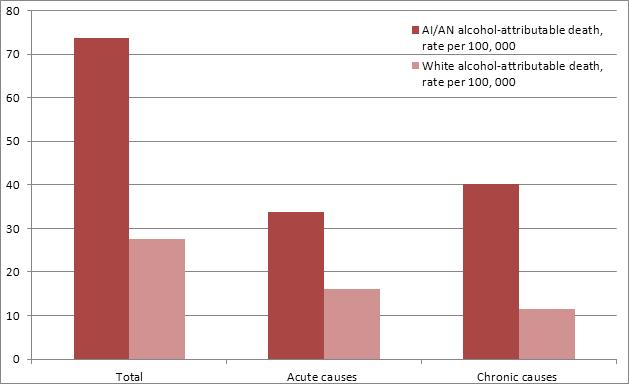The DRAM, Vol. 10(12) – Alcohol attributable deaths among Native and non-Native groups
The consequences of excessive alcohol consumption are a serious burden on any population. Alcohol-related mortality accounts for the highest proportion of preventable deaths in the United States but represents a more serious health concern in certain groups, including American Indians and Alaska Natives (AI/ANs) (May, 1994). This week, as part of our Special Series on Addiction and Recovery among Tribal Communities, The DRAM reviews a study of drinking-related deaths among American Indians and Alaska Natives (Landen, Roeber, Naimi, Nielsen, & Sewell, 2014).
Methods
- The researchers used population estimates developed by the US Census Bureau and the Centers for Disease Control and Prevention’s National Center Statistics, as well as National Death Index records, to calculate alcohol-attributable death rates for AI/AN and White individuals for the period 1999-2009. They excluded individuals of Hispanic origin.
- They obtained race from death certificates and, for AI/AN individuals, through linkage with the Indian Health Service (IHS) patient registration database.
- The researchers defined “alcohol attributable deaths” as deaths that are 100% attributable to excessive alcohol consumption ( e.g. alcoholic cirrhosis of the liver).
- For deaths during the period 2005-2009, the researchers separated acute (e.g. motor vehicle traffic crashes, suicide, hypothermia) from chronic (e.g. alcoholic liver disease, alcohol dependence/abuse, hypertension, liver cancer) alcohol-related causes of death and computed rates separately for geographical region (total deaths = 6,764 for AI/AN; 667,183 for Whites).
Results
- Across the period 1999-2009, AI/ANs had higher rates of alcohol-attributable death than Whites. For instance, during 2009, the rates of alcohol-attributable deaths per 100,000 were 98.9 for AI/AN males, 51.6 for AI/AN females, 40.2 for White males, and 16.1 for White females.
- Furthermore, in the period from 2005 – 2009, the AI/AN to White rate ratio was 2.7. In other words, an AI/AN individual’s death was almost 3 times as likely as a White death to be classified as alcohol-attributable.
- The researchers performed more specific comparisons for deaths during the period 2005-2009:
- Among AI/AN individuals, those in the Northern Plains had the highest rate of alcohol-attributable death (123.8) and those in the East had the lowest rate (48.9).
- The most noticeable difference in rates between racial groups can be seen in chronic (as opposed to acute) causes of alcohol-attributable deaths (Figure 1).

Figure 1. Alcohol attributable death rates per 100, 000 for each race separated by cause of death. Adapted from Landen et al., 2014.
Limitations
- Classification of race for AI/AN is difficult, particularly post-mortem. For example, not all AI/AN individuals are members of federally recognized tribes and are therefore not represented in the IHS database. As a result, population rates are imperfect.
- Exclusion of Hispanic AI/AN individuals disproportionately affected some states.
- Certain events, such as homicide and suicide– two potential types of alcohol-attributable deaths– are more likely to be underreported within AI/AN groups than within White groups. Therefore, differences observed in this study could be underestimates of true population differences.
Conclusions
There is higher relative risk of alcohol-attributable death for AI/AN individuals compared to Whites across the United States. The discrepancy between the AI/AN and White populations has been consistent in its nature, without significant fluctuation evident in the decade of data the researchers studied. The results of this study indicate that excessive alcohol use is an insidious problem within AI/AN communities and necessitates targeted, early-intervention and prevention strategies and programs aimed at reducing alcohol consumption and related consequences. Increased alcohol taxes, limited hours of sale, electronic screening and brief intervention, and enhanced enforcement of laws prohibiting sales to minors are strategies that have shown promise in the general population. Among the AI/AN population specifically, culturally based healing programs, such as the Wellbriety Movement, might prove especially helpful in promoting sobriety, recovery, and general wellness.
– Emily Shoov
What do you think? Please use the comment link below to provide feedback on this article.
References
Landen, M., Roeber, J., Naimi, T., Nielsen, L., & Sewell, M. (2014). Alcohol-Attributable Mortality Among American Indians and Alaska Natives in the United States, 1999-2009. American Journal of Public Health (published online ahead of print), e1-e7.
May, A. P. (1994) The epidemiology of alcohol abuse among American Indians: the mythical and real properties. American Indian Culture and Research Journal,12(2). P121-143.